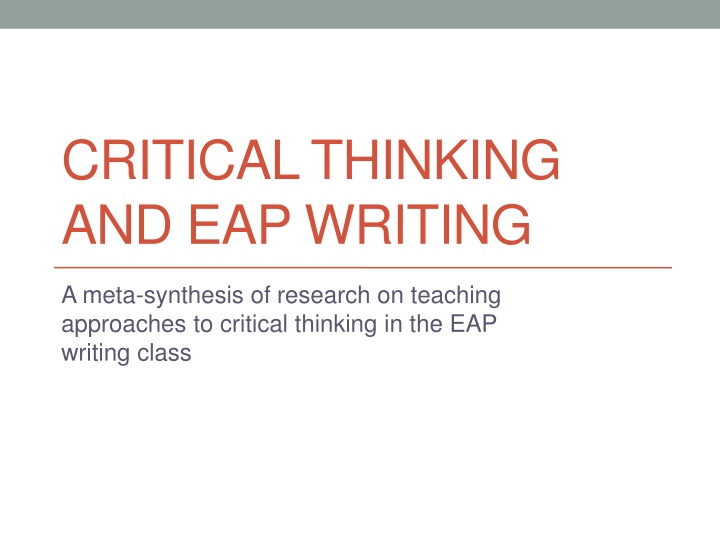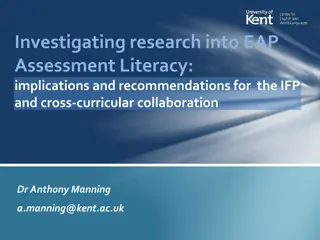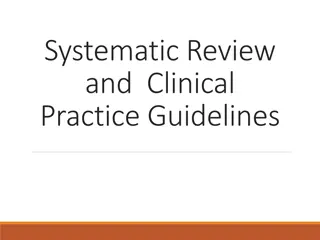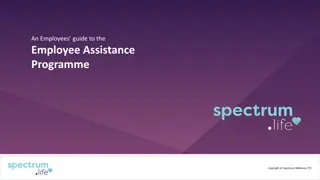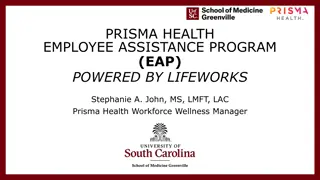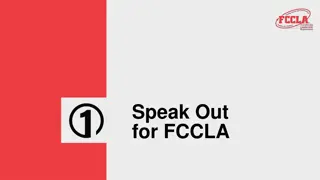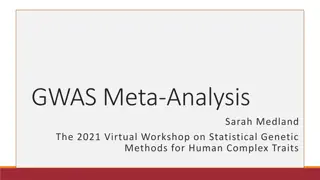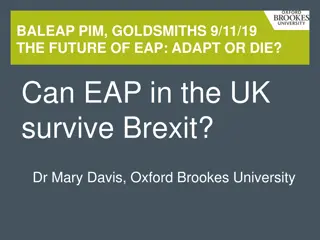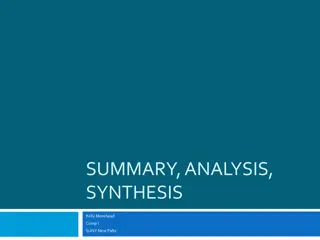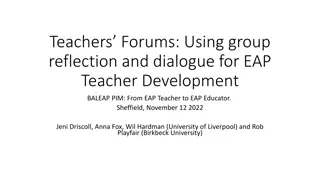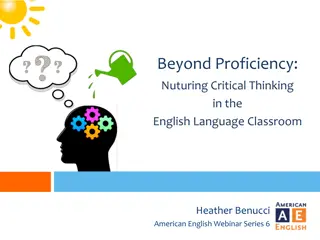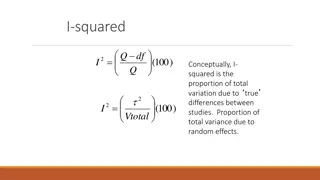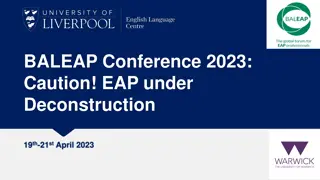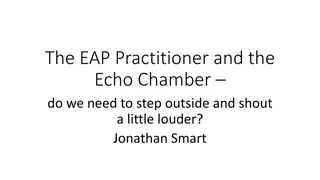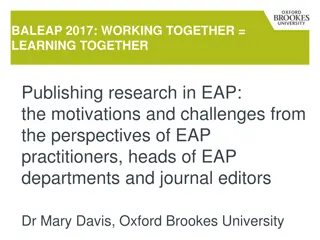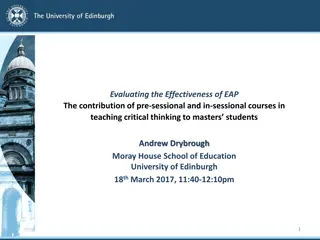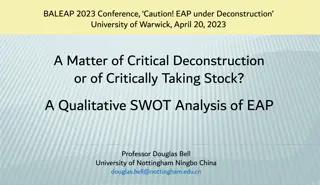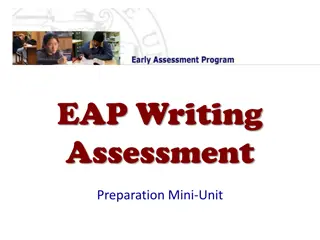Enhancing Critical Thinking in EAP Writing: A Meta-Synthesis Study
Investigating the teaching approaches to critical thinking in EAP writing classes, this meta-synthesis research delves into the importance of critical thinking, key issues in the literature review, defining critical thinking, enhancing criticality in academic writing, and understanding critical thinking across academic disciplines and cultures. The methodology involves analyzing empirical studies to identify key aspects and approaches in developing critical thinking skills among EAP students.
Download Presentation

Please find below an Image/Link to download the presentation.
The content on the website is provided AS IS for your information and personal use only. It may not be sold, licensed, or shared on other websites without obtaining consent from the author.If you encounter any issues during the download, it is possible that the publisher has removed the file from their server.
You are allowed to download the files provided on this website for personal or commercial use, subject to the condition that they are used lawfully. All files are the property of their respective owners.
The content on the website is provided AS IS for your information and personal use only. It may not be sold, licensed, or shared on other websites without obtaining consent from the author.
E N D
Presentation Transcript
CRITICAL THINKING AND EAP WRITING A meta-synthesis of research on teaching approaches to critical thinking in the EAP writing class
Introduction Background to the study Research conducted as part of my Masters study Importance of CT in academic contexts vs ambiguity surrounding the concept Overview Definition Key issues raised in the lit review Methodology Findings implications for teaching practices
What exactly is critical thinking? the concept of critical thinking remains more elusive than ever (Davies & Barnett, 2015) Critical thinking in an academic context involves both Skills and Dispositions: Analysis/Evaluation Synthesis Argument construction Making connections Identifying problems/ proposing solutions Critical spirit Willingness to inquire Self-reflexive stance
Critical thinking and academic writing the skill of critical writing lies in convincing your readers to accept your claims. You achieve this through the effective communication of adequate reasons and evidence for these claims (Wallace & Wray, 2011:7) Student papers lack criticality due to: Poor reasoning/lack of argument Making unsupported claims Being predominantly descriptive Little or no clear stance/voice (Goodwin, 2014; Alagozlu, 2007, Woodward-Kron, 2002)
Critical thinking across academic disciplines & cultures Different disciplines give priority to different aspects: applied disciplines - reflection and connections between theory & practice science faculties - the importance of identifying problems and proposing solutions (Carmicheal et al, 1995) Perception that Eastern students can t think critically
Methodology Research Questions: What skills, dispositions and knowledge do EAP students and teachers believe constitute key aspects of critical thinking in an academic context? What approaches are being taken with regard to developing students critical thinking skills in academic writing tasks? Method: Meta-synthesis of empirical studies Studies identified through a key word search using ERIC Studies analysed using a framework of critical thinking attributes
Findings: Misconceptions An author gives a theory and I say that according to my experience there is something wrong with his theory or definition (Durkin, 2008:21) Although I understand the meaning of critical writing and thinking, I still feel uneasy to criticize other people ideas, especially when they are more senior than me, for example my supervisor (Melles, 2009:167)
Evaluation & Synthesis I don t see why we always have to write so much about what other people have written. Often I have a lot of individual thoughts, but I don t find them in journals or books. What about these? (Durkin, 2008:22) Key issues for international students: struggle to find and express their own voice linguistic demands & cognitive load
Content & Background Knowledge Sustained content-based approach To question, analyse or recognise bias background knowledge is necessary Reflects purpose of academic writing not purely assessment but to deepen understanding Builds confidence as it provides scaffolding (Pally, 2001) Advantage of embedding CT in a disciplinary-specific context *Overall CT skills perceived as generalisable and transferable (Melles, 2009)
Collaboration Collaborative pre-writing activities and discussion tasks as a way to promote critical thinking Increases students willingness to question Builds confidence Helps broaden and consolidate knowledge (Kasper & Weis, 2005) Discussion in the pre-writing stage promotes critical reflection Role of group dynamics in this process (McDonough & Neumann, 2014)
Conclusion clarifying expectations and taking time in the classroom to discuss students interpretations of critical thinking not restricting the definition of critical thinking presented to the students too narrowly Allowing time and space for collaboration in the writing classroom Considering the role of content and discipline-specific approaches Place of critical reflection in the academic context
References Alagozlu, N. (2007). Critical thinking and voice in EFL writing. Asian EFL Journal Quarterly 9(3), pp.118-136 Carmichael, E., Cragie, D., Driscoll, K., Farrell, H., James, B. & Scoufis, M. (1995). Critical analysis What is it? Sydney: University of Western Sydney Nepean. Davis, M. & Barnett, R. (2015). Introduction. In Davis, M. & Barnett, R. (Eds). The Palgrave Handbook of Critical Thinking in Higher Education, pp1-26. Basingstoke: Palgrave MacMillan. Durkin, K. (2008). The adaptation of East Asian masters students to Western norms of critical thinking and argumentation in the UK. Intercultural Education 19(1), pp.15- 27 Goodwin, B. (2014). Teach critical thinking to teach writing. Educational Leadership 71(7), pp.78-80
Kasper, L. & Weiss, S. (2005). Building ESL students linguistic and academic literacy through content-based interclass collaboration. TETYC 32(3), pp.282-297 McDonough, K. & Neumann, H. (2014). Using prewriting tasks in L2 writing classes: insights from three experiments. TESL Canada Journal 31(8), pp.132-143 Melles, G. (2009). Teaching and evaluation of critical appraisal skills to postgraduate ESL engineering students. Innovations in Education and Teaching International 46(2), pp.161-170 Pally, M. (2001). Skills development in Sustained Content-Based Curricula: Case studies in analytical/critical thinking and academic writing. Language and Education 15(4), pp. 279-305 Thomas, K. & Lok, B. (2015). Teaching critical thinking: An operational framework. In Davis, M. & Barnett, R. (Eds). The Palgrave Handbook of Critical Thinking in Higher Education, pp.93-105. Basingstoke: Palgrave MacMillan Wallace, M. & Wray, A. (2011). Critical Reading and Writing for postgraduates 2nd ed. London: SAGE Publications Woodward-Kron, R. (2002). Critical analysis versus description? Examining the relationship in successful student writing. Journal of English for Academic Purposes 1(2), pp.121-143
